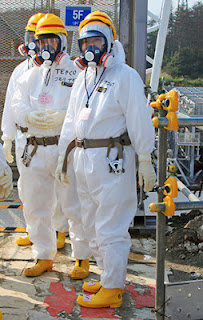Does anybody remember the Fukushima nuclear disaster?
 |
| Yoshihiko Noda |
In what could be basically a photo op for the Democratic Party of Japan (DPJ) Prime Minister (Noda) in an attempt to shore up his dwindling popularity in the run up to a general election widely speculated to return power to a possible new coalition government headed by the Liberal Democratic Party (LDP), he paid an “inspection” visit to the crippled Fukushima nuclear plant. Apart from posing in a white protective suit and hard hat and expressing "heartfelt" thanks to the Tepco workers who risked their lives in the immediate aftermath of the tsunami disaster its hard to see what “inspection” value there was in a look see by someone who knows nothing about nuclear energy.
Be that as it may, an article in The Japan Times by staff writer Reiji Yoshida does give a bit of an update on the current conditions at Fukushima. The overall message seems to be that things haven't gotten worse but it will take a very long time to clean up the mess.
Since Fukushima has potentially much farther-reaching consequences than some rocks in the sea for people other than the nationalist nutjobs shooting water pistols at each other, sane people might be interested in learning about the current state of ongoing repairs or non-repairs there. Here are a few excerpts from the article:
Experts say that over the past year, the risk of another serious accident at the plant has considerably lessened, although long-term concerns about the durability of equipment and facilities remain since decommissioning the reactors could drag on for up to 40 years.
Plant workers are now speeding up work to remove about 1,500 nuclear fuel assemblies stored in a spent-fuel pool on the fourth floor of the No. 4 reactor building, which suffered extensive damage from a hydrogen explosion.
Tepco now plans to start extracting the fuel assemblies by the end of next year, and to finish moving them to another spent-fuel pool designed for long-term storage by the end of 2015.
Once accomplished, the likelihood of another serious accident will be even slimmer, according to Kyoto University professor Hajimu Yamana...
"There won't be any more serious trouble unless something extraordinary happens," Yamana said, pointing out that simulations by plant operator Tokyo Electric Power Co. showed the reactor 4 building can withstand an earthquake measuring upper 6 on the Japanese seismic intensity scale of 7.
But it's better to move all the spent fuel to the second pool, which is more resistant to earthquakes and has a better cooling system, Yamana noted, because "you can't totally deny the possibility of (another) gigantic earthquake" striking the area.
Meanwhile, the remaining decay heat from the nuclear fuel in the damaged reactor cores is estimated to have fallen to 1 megawatt from 2.35 megawatts over the past year as radiation is emitted, according to calculations by Tepco.
This has considerably reduced the risk of another disaster at the complex "and as time passes, (Tepco) will get greater scope" to fix the critical water coolant system, Yamana said.
The decay heat is expected to fall to 0.61 megawatt by next October and to 0.42 megawatt a year later, according to Tepco's data.
The question is how much trust and confidence you have in Tepco's calculations!









0 komentar:
Posting Komentar